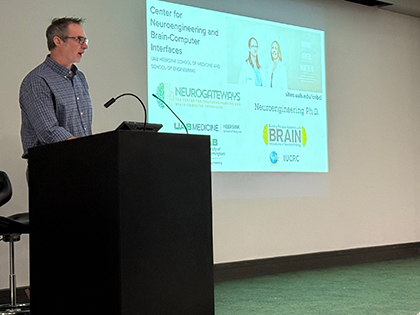A recent day-long workshop at UAB Highlands sought to kickstart an initiative to foster a new generation of entrepreneurs in a field that is at the cutting-edge of modern-day medicine.
The “Innovate and Launch Neurotech Entrepreneurship Workshop” was put on by the UAB Center for Neuroengineering and Brain-Computer Interfaces. The event was led by faculty and administrators from UAB’s Neuroengineering Ph.D. Program—a joint program run by the UAB Heersink School of Medicine and the School of Engineering—as well as the UAB Harbert Institute for Innovation and Entrepreneurship (HIIE).
“The rules are changing in higher education in terms of how to secure funding for research into new technologies,” said William “Jamie” Tyler, Ph.D., co-director of the Neuroengineering Ph.D. Program. “We’re going to need to identify different avenues of funding, and those avenues will likely require more accountability from us to produce commercially viable results quickly.”
To accomplish that, researchers at UAB rely on HIIE to help guide them through the processes and regulations that govern innovation and often create barriers between university research and commercial enterprises.
“Companies don’t typically invest in the research required to develop new technology,” said Wink Crittenden, Ph.D., licensing associate for HIIE. “They’re more likely to acquire companies that have already implemented the technology. A better way to move tech out of the university setting is through start-ups.”
That process of moving from an idea in a university lab to a commercial product was a focus of the workshop, which included presentations from several UAB entities as well as industry leaders. Among the speakers and topics were:
- Molly Wasko, Ph.D.; professor, UAB Collat School of Business; “Business Development & Entrepreneur Resources”
- Lloyd Cooper; co-founder, PUSH Product Design; “Design: From Concept to First Prototypes”
- Erik Schwiebert, Ph.D.; Director, Station 41 Accelerator, Southern Research; “Incubators and Innovation Partners”
- Miller Girvin; President, Economic Development Partnership of Alabama; “The Entrepreneurial Mindset”
- Vivek Lal, M.D., UAB Department of Pediatrics and Director of UAB’s Heersink Institute of Biomedical Innovation; “Building a Founding Team”
- Patrick Murphy, Ph.D., professor and Goodrich Entrepreneurship Chair, UAB Collat School of Business and Frank J. Barefield Jr. Entrepreneurship Program; “The Entrepreneurial Mindset”
The multidisciplinary background of the speakers was by design, organizers said, since collaboration across disciplines is often critical to a startup’s success. "Developing a strong entrepreneurial mindset is vital to launching new ventures and securing resources in changing environments,” Murphy explained. “Individuals can do a lot in this regard. But if individuals coordinate across fields at workshops like this one, the outcomes are magnified."
In addition to those presentations, the workshop included start-up pitches from teams of current UAB faculty and students. The pitches were limited to five minutes for each project, with two-minutes for follow-up questions from judges.
- Speech Therapy App for All;
- Project NeuroBridge: Bridging the Stroke Care Gap in Rural Communities with a Novel Blood Biomarker Kit;
- Virtual Interactive Brain Atlas (VIBA): An Innovative Educational Tool for Neuroscience Students;
- MRI-Visible Nanofiber-Coating for Surgical Instruments;
- NeurOptiks;
- and Curanostics AI Health Platform.
Pitches were evaluated on problem clarity and impact, commercial feasibility and team execution and plan, among other criteria. First-place was awarded to NeuroBridge with honorable mentions and a tie for second place going to Curanostics and VIBA. The CNBCI aims to assist all teams meet some near-term milestones through collaboration and community engagement.
“We hope this will be the first of many events of this type to help students navigate the path from idea to startup success,” Tyler said. “There isn’t any roadmap you can follow that will guarantee success, but there are many tools and a large knowledge base at UAB. By bringing people together to explore these opportunities, we can position ourselves and our students to have their best chances of succeeding. We have a lot of depth and experience in our community to surround these students’ bright ideas”
